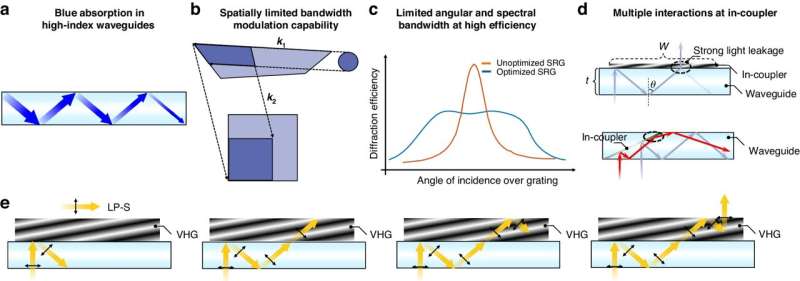This article has been reviewed according to Science X's editorial process and policies. Editors have highlighted the following attributes while ensuring the content's credibility:
fact-checked
peer-reviewed publication
trusted source
proofread
Polarization volume gratings break uniformity-efficiency tradeoff in AR waveguide displays

Augmented reality (AR) has evolved from a futuristic concept to a widespread technology, thanks to advancements in microdisplay technologies, ultracompact imaging optics, and high-speed digital processors.
By blending virtual content with real-world scenes, AR enhances our interaction with the environment, enabling applications in education, health care, navigation, gaming, and manufacturing.
Significant strides have been made in waveguide-based AR displays, resulting in lightweight, slim wearable systems with improved optical performance, driven by innovations in couplers like partial reflective mirrors, surface relief gratings, volume holographic gratings, polarization volume gratings (PVGs), metasurfaces, etc.
However, the low efficiency of waveguide displays, particularly diffractive types, remains a challenge, limiting the operational time of modern battery-powered near-eye displays.
In a paper published in Light Science & Applications, a team of scientists led by Prof. Shin-Tson Wu from the University of Central Florida and Prof. Yuning Zhang from Nanjing University has analyzed the causes of low optical efficiency in waveguide-based AR displays.
They identified significant light leakage at in-couplers, caused by multiple interactions necessary for maintaining good eyebox uniformity. To address this, the team discovered an anomalous polarization conversion phenomenon in PVGs. This phenomenon offers an intuitive solution to the tradeoff between in-coupling efficiency and uniformity throughout the eyebox and field of view (FoV).
Utilizing this discovery, the researchers have surpassed the in-coupling efficiency limits of conventional waveguide-based AR displays, effectively reducing light leakage and improving in-coupling efficiency and FoV uniformity by factors of 2 and 2.3, respectively.
This advancement highlights the superiority of PVGs as couplers in waveguide-based AR displays, marking a significant step forward in the development of high-efficiency AR technology.
PVGs are polarization-selective holographic optical elements that record the polarization information of two interfering beams comprising a right-handed circular polarization (RCP) and a left-handed circular polarization (LCP). Featuring a slanted cholesteric liquid crystal (CLC) structure, PVGs selectively reflect circular polarization states matching the helical twist while transmitting the light with an opposite circular polarization state.
However, the researchers found an anomalous phenomenon that deviates from the above-mentioned rule. When the incident angle in the glass substrate approaches the Bragg plane, the PVG acts as a waveplate instead of a grating, altering the polarization state of the incident light.
Thanks to these two superior polarization properties, using PVG as an in-coupler in waveguide displays can dramatically enhance in-coupling efficiency and uniformity across the FoV, while maintaining excellent eyebox continuity compared to traditional and metasurface couplers.
Specifically, incident LCP light is initially deflected into the waveguide substrate and retains its polarization state due to PVG's polarization selectivity. After the first interaction and total internal reflection (TIR), the polarization state of light converts to RCP.
Upon the second interaction with the PVG, the light undergoes polarization conversion, turning back to LCP if the PVG thickness meets the half-wave condition. Following another TIR, the light becomes RCP and is transmitted through the PVG, enabling it to propagate inside the waveguide while maintaining its direction. Consequently, this process significantly improves in-coupling efficiency and uniformity, while maintaining a desired eyebox continuity.
This discovery marks a significant advancement in high-efficiency waveguide-based AR displays, showcasing the superiority of PVGs over traditional and metasurface in-couplers.
More information: Yuqiang Ding et al, Breaking the in-coupling efficiency limit in waveguide-based AR displays with polarization volume gratings, Light: Science & Applications (2024). DOI: 10.1038/s41377-024-01537-8
Journal information: Light: Science & Applications
Provided by Chinese Academy of Sciences





















